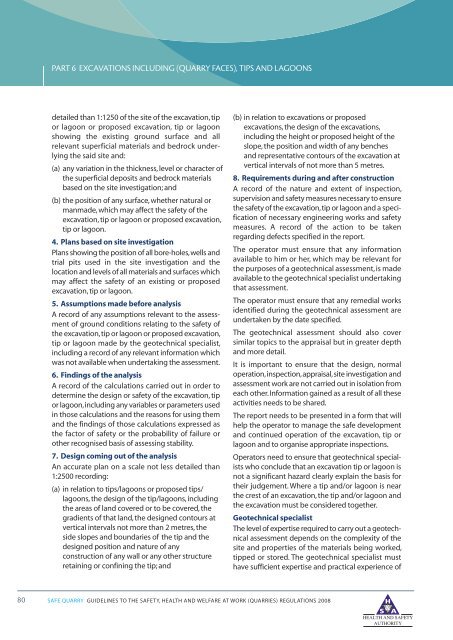Safe Quarry - Health and Safety Authority
Safe Quarry - Health and Safety Authority
Safe Quarry - Health and Safety Authority
You also want an ePaper? Increase the reach of your titles
YUMPU automatically turns print PDFs into web optimized ePapers that Google loves.
PART 6 EXCAVATIONS INCLUDING (QUARRY FACES), TIPS AND LAGOONS<br />
detailed than 1:1250 of the site of the excavation,tip<br />
or lagoon or proposed excavation, tip or lagoon<br />
showing the existing ground surface <strong>and</strong> all<br />
relevant superficial materials <strong>and</strong> bedrock underlying<br />
the said site <strong>and</strong>:<br />
(a) any variation in the thickness, level or character of<br />
the superficial deposits <strong>and</strong> bedrock materials<br />
based on the site investigation; <strong>and</strong><br />
(b) the position of any surface, whether natural or<br />
manmade, which may affect the safety of the<br />
excavation, tip or lagoon or proposed excavation,<br />
tip or lagoon.<br />
4. Plans based on site investigation<br />
Plans showing the position of all bore-holes,wells <strong>and</strong><br />
trial pits used in the site investigation <strong>and</strong> the<br />
location <strong>and</strong> levels of all materials <strong>and</strong> surfaces which<br />
may affect the safety of an existing or proposed<br />
excavation, tip or lagoon.<br />
5. Assumptions made before analysis<br />
A record of any assumptions relevant to the assessment<br />
of ground conditions relating to the safety of<br />
the excavation,tip or lagoon or proposed excavation,<br />
tip or lagoon made by the geotechnical specialist,<br />
including a record of any relevant information which<br />
was not available when undertaking the assessment.<br />
6. Findings of the analysis<br />
A record of the calculations carried out in order to<br />
determine the design or safety of the excavation, tip<br />
or lagoon,including any variables or parameters used<br />
in those calculations <strong>and</strong> the reasons for using them<br />
<strong>and</strong> the findings of those calculations expressed as<br />
the factor of safety or the probability of failure or<br />
other recognised basis of assessing stability.<br />
7. Design coming out of the analysis<br />
An accurate plan on a scale not less detailed than<br />
1:2500 recording:<br />
(a) in relation to tips/lagoons or proposed tips/<br />
lagoons, the design of the tip/lagoons, including<br />
the areas of l<strong>and</strong> covered or to be covered, the<br />
gradients of that l<strong>and</strong>, the designed contours at<br />
vertical intervals not more than 2 metres, the<br />
side slopes <strong>and</strong> boundaries of the tip <strong>and</strong> the<br />
designed position <strong>and</strong> nature of any<br />
construction of any wall or any other structure<br />
retaining or confining the tip; <strong>and</strong><br />
(b) in relation to excavations or proposed<br />
excavations, the design of the excavations,<br />
including the height or proposed height of the<br />
slope, the position <strong>and</strong> width of any benches<br />
<strong>and</strong> representative contours of the excavation at<br />
vertical intervals of not more than 5 metres.<br />
8. Requirements during <strong>and</strong> after construction<br />
A record of the nature <strong>and</strong> extent of inspection,<br />
supervision <strong>and</strong> safety measures necessary to ensure<br />
the safety of the excavation,tip or lagoon <strong>and</strong> a specification<br />
of necessary engineering works <strong>and</strong> safety<br />
measures. A record of the action to be taken<br />
regarding defects specified in the report.<br />
The operator must ensure that any information<br />
available to him or her, which may be relevant for<br />
the purposes of a geotechnical assessment, is made<br />
available to the geotechnical specialist undertaking<br />
that assessment.<br />
The operator must ensure that any remedial works<br />
identified during the geotechnical assessment are<br />
undertaken by the date specified.<br />
The geotechnical assessment should also cover<br />
similar topics to the appraisal but in greater depth<br />
<strong>and</strong> more detail.<br />
It is important to ensure that the design, normal<br />
operation,inspection,appraisal,site investigation <strong>and</strong><br />
assessment work are not carried out in isolation from<br />
each other.Information gained as a result of all these<br />
activities needs to be shared.<br />
The report needs to be presented in a form that will<br />
help the operator to manage the safe development<br />
<strong>and</strong> continued operation of the excavation, tip or<br />
lagoon <strong>and</strong> to organise appropriate inspections.<br />
Operators need to ensure that geotechnical specialists<br />
who conclude that an excavation tip or lagoon is<br />
not a significant hazard clearly explain the basis for<br />
their judgement. Where a tip <strong>and</strong>/or lagoon is near<br />
the crest of an excavation, the tip <strong>and</strong>/or lagoon <strong>and</strong><br />
the excavation must be considered together.<br />
Geotechnical specialist<br />
The level of expertise required to carry out a geotechnical<br />
assessment depends on the complexity of the<br />
site <strong>and</strong> properties of the materials being worked,<br />
tipped or stored. The geotechnical specialist must<br />
have sufficient expertise <strong>and</strong> practical experience of<br />
80<br />
SAFE QUARRY GUIDELINES TO THE SAFETY, HEALTH AND WELFARE AT WORK (QUARRIES) REGULATIONS 2008
















